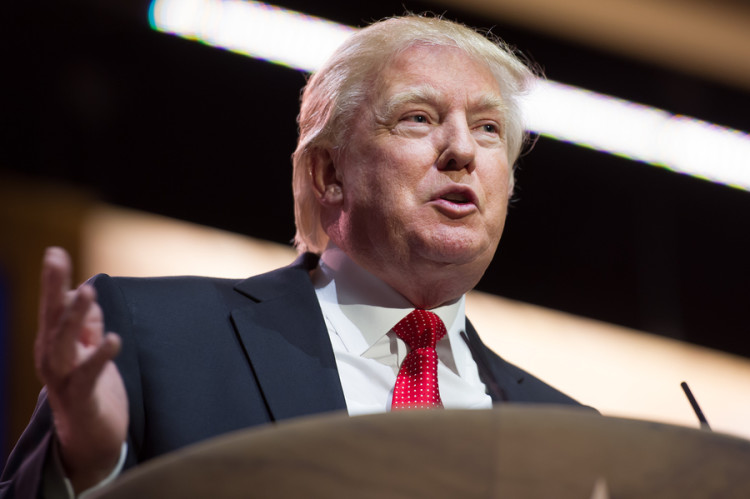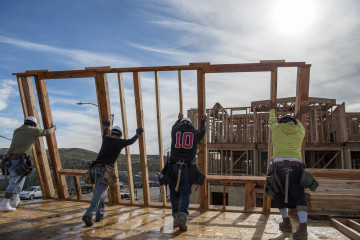Trump Immigration Ban Bound for Supreme Court, Now or Later

published Feb 6th 2017, 7:02 am, by Kartikay Mehrotra and Chris Dolmetsch
(Bloomberg) —
President Donald Trump’s effort to bar travelers from seven mostly Muslim nations is on a track to the U.S. Supreme Court, which may eventually decide how much authority the executive branch has on immigration and national security.
The ban affecting business travelers, students, immigrants and refugees may be re-imposed as early as Monday if an appeals court puts on hold a judge’s order blocking it while the legal fight continues.
“Overturning the ruling would cause such anguish and confusion at the borders,” said Jayashri Srikantiah, a Stanford Law School professor who specializes in immigration. She said it’s “extremely hard to bet” as to what the appeals court will do, “but one can imagine the confusion caused by reversing the TRO is something the court is taking into consideration.”
The Trump administration is asking the liberal-leaning U.S. Court of Appeals in San Francisco to throw out the restraining order won by Washington state and Minnesota, which contend the travel ban hurts their residents and employers including Microsoft Corp., Amazon.com Inc. and the Mayo Clinic. Hawaii Attorney General Doug Chin filed a motion on Sunday to join Minnesota and Washington in the lawsuit opposing Trump’s 90-day travel ban.
Minnesota and Washington met a deadline early Monday morning to file their argument against that request, while the U.S. Justice Department has until 3 p.m. Monday to make its final argument. A decision could come anytime after that and the losing side may make a quick run to the Supreme Court.
“Those who were abroad were blocked from returning home,” the two states said in the filing. “Husbands were separated from wives, brothers from sisters and parents from their children.”
Trump attacked news media polls on the issue Monday. “Any negative polls are fake news, just like the CNN, ABC, NBC polls in the election. Sorry, people want border security and extreme vetting,” he tweeted.
A CNN/ORC International poll released Friday found that 53 percent of Americans oppose Trump’s order, while six in 10 oppose Trump’s proposal to build a wall along the U.S.-Mexico border. A CBS News poll reported Friday found 51 percent disapprove of his immigration order.
Earlier polls found the results of similar questions slightly reversed. Quinnipiac University data showed Americans favored suspending immigration from terror-prone regions 48 percent to 42 percent, and Reuters/Ipsos respondents supported the ban 49 percent to 41 percent.
Protests, Lawsuits
Trump’s Jan. 27 executive order blocked or delayed travelers, including those with visas and permanent residents with green cards, from entering the country. The detention of dozens and the return of others to their departure points set off spontaneous protests and a storm of litigation, mostly on behalf of individuals. The cases including those involving state attorneys general have led to mixed rulings, some of them blocking parts of Trump’s executive order.
The case brought by Washington Attorney General Bob Ferguson and joined by Minnesota made the most sweeping arguments against the ban, citing the economic damage as well as the personal toll on residents of the state. U.S. District Judge James Robart, in granting the restraining order on Friday, concluded the states were likely to win the case when the substance of their arguments was reviewed in more depth later when a longer-lasting order is considered.
Trump, who labeled Robart a “so-called judge,” continued criticizing him Sunday on Twitter.
Blame Judge
“I just cannot believe a judge would put our country in such peril. If something happens blame him and court system. People pouring in. Bad!” Trump said in a tweet Sunday.
The president has discretion in matters of national security involving immigration, the Justice Department contends.
In its appeal, the Justice Department said the Seattle ruling should be put on hold because it conflicts with a 1982 Supreme Court opinion stating that immigrants’ constitutional privileges must be approved by the U.S. upon initial entry. The judge also failed to “confront” Congress’s judgment that the “president should have the unreviewable authority to suspend the admission of any class of alien,” it said.
The states contend the president’s edict discriminates against immigrants and permanent U.S. residents and violates the Religious Freedom Restoration Act. The states allege that Trump’s executive order violates the First Amendment and Fifth Amendment of the Constitution, which protect rights to religious freedom and equal protection.
Supreme Court
If the federal government fails to persuade the appeals court to block the order, it might petition the Supreme Court to intervene. Five of the eight justices would be needed to reverse that decision.
“I think it’s unlikely this makes it to the Supreme Court,” said Kathleen Kim, a professor at Loyola Law School in Los Angeles. “I believe that if the Supreme Court wants to maintain its integrity as a majoritarian body serving as a legitimate system for checks and balances, it will not consider an appeal.”
That would leave the merits of the arguments to be debated in a Seattle courtroom, with the case and perhaps others making their way to the top court for review in months or even years — especially if appeals courts issue conflicting rulings on whether it’s legal.
The immigration case has already cropped up in the confirmation process for Supreme Court nominee Neil Gorsuch, with Democrats questioning whether he would be able to check Trump’s exercise of executive power. Gorsuch, a conservative who favors originalism when interpreting the Constitution, could be the tie-breaking vote on the currently split court.
Liberal Leaning
Before then, the San Francisco appeals court might be hard to predict, too.
The court covers most of the western U.S., with jurisdiction over Alaska, Arizona, California, Hawaii, Idaho, Montana, Nevada, Oregon and Washington, covering about 20 percent of the U.S. population. All but a quarter of its judges were appointed by Democratic presidents.
The court’s reputation as a liberal bastion was reinforced by some of its rulings in the past year. In November, the court blocked Arizona from enforcing its ban on so-called ballot harvesting, a practice favored by Democrats because it allows voters in remote areas to have their ballots brought to the polls by another person. In June, the court threw out an earlier ruling striking California’s strict laws on who can can carry concealed weapons.
Still, a three-judge panel may be reluctant to allow the temporary order to remain in effect because the law is very restrictive when it comes to allowing states to represent others, said John Banzhaf, a professor at George Washington University Law School.
“The idea that one judge in one jurisdiction after a relative brief hearing shut down an entire governmental operation directed by the president is somewhat disconcerting to many people,” Banzhaf said. “It is very unusual, almost rare but not unprecedented, for a district court to issue an order covering not only the United States of America but dozens of people in foreign countries. The court may blanch at that.”
The case is State of Washington v. Trump, 17-35105, U.S. Court of Appeals for the Ninth Circuit (San Francisco). The lower-court case is State of Washington v. Trump, 17-cv-00141, U.S. District Court, Western District of Washington (Seattle).
-With assistance from Greg Stohr and Anthony Aarons. To contact the reporters on this story: Kartikay Mehrotra in San Francisco at kmehrotra2@bloomberg.net ;Chris Dolmetsch in New York State Supreme Court in Manhattan at cdolmetsch@bloomberg.net To contact the editors responsible for this story: Michael Hytha at mhytha@bloomberg.net ;David Glovin at dglovin@bloomberg.net Elizabeth Wasserman, Elizabeth Titus
COPYRIGHT
© 2017 Bloomberg L.P







No Comment